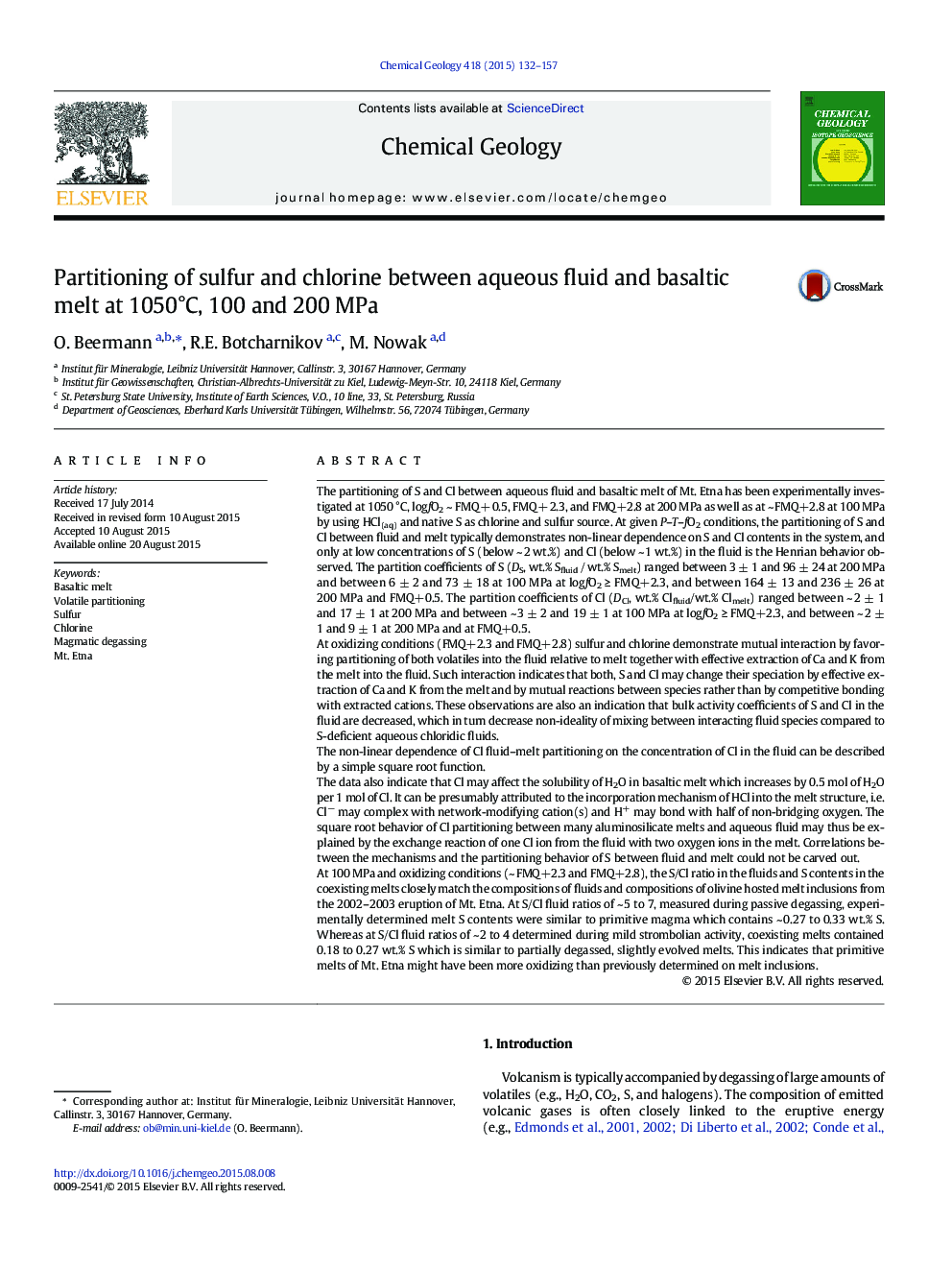| کد مقاله | کد نشریه | سال انتشار | مقاله انگلیسی | نسخه تمام متن |
|---|---|---|---|---|
| 6436203 | 1637556 | 2015 | 26 صفحه PDF | دانلود رایگان |

- S and Cl partitioning between basalt and aqueous fluid is mostly non-ideal.
- Effective interaction of S and Cl occur at oxidizing redox conditions.
- Cl increases the S solubility in the fluid.
- Addition of S evidently enhances mixing properties of metal chloride-O-H fluids.
- S and Cl mutually decrease their activity in the fluid.
The partitioning of S and Cl between aqueous fluid and basaltic melt of Mt. Etna has been experimentally investigated at 1050 °C, logfO2 ~ FMQ + 0.5, FMQ + 2.3, and FMQ+2.8 at 200 MPa as well as at ~ FMQ+2.8 at 100 MPa by using HCl(aq) and native S as chlorine and sulfur source. At given P-T-fO2 conditions, the partitioning of S and Cl between fluid and melt typically demonstrates non-linear dependence on S and Cl contents in the system, and only at low concentrations of S (below ~ 2 wt.%) and Cl (below ~ 1 wt.%) in the fluid is the Henrian behavior observed. The partition coefficients of S (DS, wt.% Sfluid / wt.% Smelt) ranged between 3 ± 1 and 96 ± 24 at 200 MPa and between 6 ± 2 and 73 ± 18 at 100 MPa at logfO2 â¥Â FMQ+2.3, and between 164 ± 13 and 236 ± 26 at 200 MPa and FMQ+0.5. The partition coefficients of Cl (DCl, wt.% Clfluid/wt.% Clmelt) ranged between ~ 2 ± 1 and 17 ± 1 at 200 MPa and between ~ 3 ± 2 and 19 ± 1 at 100 MPa at logfO2 â¥Â FMQ+2.3, and between ~ 2 ± 1 and 9 ± 1 at 200 MPa and at FMQ+0.5.At oxidizing conditions (FMQ+2.3 and FMQ+2.8) sulfur and chlorine demonstrate mutual interaction by favoring partitioning of both volatiles into the fluid relative to melt together with effective extraction of Ca and K from the melt into the fluid. Such interaction indicates that both, S and Cl may change their speciation by effective extraction of Ca and K from the melt and by mutual reactions between species rather than by competitive bonding with extracted cations. These observations are also an indication that bulk activity coefficients of S and Cl in the fluid are decreased, which in turn decrease non-ideality of mixing between interacting fluid species compared to S-deficient aqueous chloridic fluids.The non-linear dependence of Cl fluid-melt partitioning on the concentration of Cl in the fluid can be described by a simple square root function.The data also indicate that Cl may affect the solubility of H2O in basaltic melt which increases by 0.5 mol of H2O per 1 mol of Cl. It can be presumably attributed to the incorporation mechanism of HCl into the melt structure, i.e. Clâ may complex with network-modifying cation(s) and H+ may bond with half of non-bridging oxygen. The square root behavior of Cl partitioning between many aluminosilicate melts and aqueous fluid may thus be explained by the exchange reaction of one Cl ion from the fluid with two oxygen ions in the melt. Correlations between the mechanisms and the partitioning behavior of S between fluid and melt could not be carved out.At 100 MPa and oxidizing conditions (~ FMQ+2.3 and FMQ+2.8), the S/Cl ratio in the fluids and S contents in the coexisting melts closely match the compositions of fluids and compositions of olivine hosted melt inclusions from the 2002-2003 eruption of Mt. Etna. At S/Cl fluid ratios of ~ 5 to 7, measured during passive degassing, experimentally determined melt S contents were similar to primitive magma which contains ~ 0.27 to 0.33 wt.% S. Whereas at S/Cl fluid ratios of ~ 2 to 4 determined during mild strombolian activity, coexisting melts contained 0.18 to 0.27 wt.% S which is similar to partially degassed, slightly evolved melts. This indicates that primitive melts of Mt. Etna might have been more oxidizing than previously determined on melt inclusions.
Journal: Chemical Geology - Volume 418, 15 December 2015, Pages 132-157